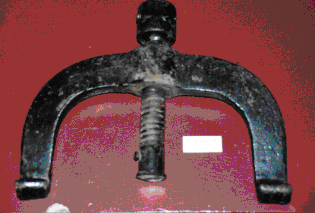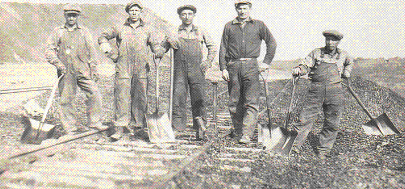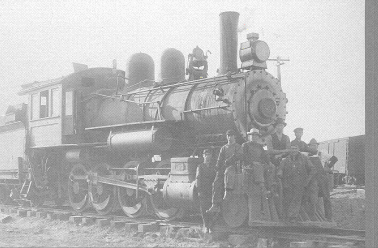
The physical features of the Canadian Pacific Railway are impressive but they often make people forget the human aspect of the project. Without the back breaking labour of workers the C.P.R. would never have been built or operated. Railway construction needed a workforce that could travel around the country in the service of railway companies. The labour force recruited by the Canadian Pacific Railway Company was made up mostly of immigrants. Many different nationalities came to work on the railways in Canada. None are better known for their efforts than the Chinese. Working primarily in the British Columbia Rocky Mountains, Chinese labourers endured not only harsh living conditions but discrimination as well. Their efforts were needed for the successful completion of the rail line through the mountains.

P19750085000-GA A rail bender was an essential tool on the railway. It was used to create slight bends in the rails so that long turns in the track could be formed.
The faces that worked on the rail line changed as often as the scenery. There were always new workers arriving to replace others who left the railway and settled in the towns along the line. In southern Alberta the construction of the rail lines attracted many different immigrants. English, American, Chinese, Polish, Hungarians, and Doukhabor workers were all known to have worked in the area. Little is known about these men, often not even their names. But the C.P.R. and smaller rail lines could not have been built without the efforts of these anonymous workers.

P19760234075-GP A work crew repairing tracks on the Narrow Gauge Line
Once the railway was built a new workforce was
needed to operate and maintain the rail lines. Many workers from
the construction crews were hired to work on the C.P.R. These
workers were hired into a variety of jobs. They worked as
engineers, conductors, porters, firemen, mechanics, and basic
labourers. 
P19760234075-GP A work crew in front of a steam engine on the Narrow Gauge Line.
 Ella Emma Dunn
Ella Emma DunnPrevious Page | Exhibit Contents | Home | Navigation Information | Glossary | Curriculum Guide | Next Page
Copyright © 1996 Sir Alexander Galt Museum. All rights reserved.